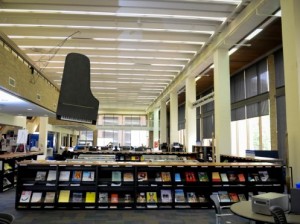The YouTube Symphony Orchestra: Classical music meets social media
I thought I would do my last post of the term on the YouTube Symphony Orchestra. It hasn’t been in the news for a few years, but it exemplifies a lot of the concepts that have been discussed in LIBR559, including creation, collaboration, and participation.
In 2009, the creation of the orchestra was announced and interested musicians were called upon to post audition tapes of themselves on YouTube. Diversity amongst the musicians in terms of cultures, instruments, and geographic locations was encouraged. Once the players were selected, the orchestra came together for a concert that year at Carnegie Hall, headed by famed conductor Michael Tilson Thomas. The first concert was such a success that they performed a second one in 2011 at the Sydney Opera House.
YouTube Symphony Orchestra Wikipedia page
YouTube Symphony Orchestra YouTube Channel
Here is a recap of the 2011 concert:
I really think this was a great idea. It is no secret that Western Classical music has always been seen as a bit elitist. The emergence of ‘music for the people’ (popular music) in the 20th century has begun to cause some problems in the Classical music world as core audiences grow ever older. Funding and popularity are becoming very serious issues both in Canada and worldwide (that link is from 2002, but it’s as relevant as ever).
In my opinion, there is way too much emphasis on tradition within the realm of Classical music, causing it to be pushed to the fringe of relevant culture. I’m generalizing a bit here, but the only people I tend to see at the local symphony are seniors and Classical music students. There simply isn’t enough being done to reach out to contemporary audiences.
With that said, here is why I’m a big fan of concepts like this one:
Diversity is encouraged
- There was a huge focus on diversity amongst both musicians, with the emphasis on non-professionals from different countries
- The performances were also diverse, with the orchestra playing excerpts from a variety of pieces from a variety of eras and styles rather than the traditional one or two major works.
It brings it to ‘the people’
- The participatory aspect is huge here in that anyone with the means to make a video and post it online could audition.
- Unlike regular Classical music events that focus on the product, the process is heavily emphasized here. The YouTube channel features a variety of behind-the-scenes type videos.
Modern technology is utilized
- The affordance of creation and collaboration through social media, with the audition process and content sharing, is a major innovation for Classical music.
- Streaming! I can’t believe more orchestras are doing this these days. I think maybe they are afraid that people will stop going to the concert hall? In reality, streaming affords access to an extremely broad audience in addition to those that attend in person.
It makes the news
- Not much that happens in Classical music makes headlines these days, but this did. There needs to be more stuff like this!
It creates sharable content
- It is great from a marketing standpoint because videos like the one I posted above, as well as the numerous others on the channel, are perfect for sharing online.
I remember seeing some favourable reviews but, of course, the traditionalists hated it. I mean come on, the Sydney Opera House concert ended up being the most watched live-stream event ever, with 33 million views worldwide! That is nothing to scoff at.
To me, the point here isn’t that orchestras across the world need to abandon traditions and start incorporating digital technology into everything they do, they just need to do more to stay relevant. In this case, social media proved to be a perfect avenue for doing just that, thanks to its creative, collaborative, and participatory nature.

